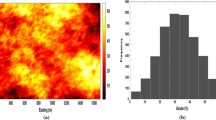Abstract
The recoverable reserves in an ore deposit depend on several factors, in particular the size of the selective mining units (support effect) and the misclassifications when sending these units to mill or dump according to their estimated grade (information effect). Both effects imply a loss of selectivity and have to be correctly forecasted. In this work, several models are reviewed and applied to a synthetic ore deposit characterized by a highly skewed grade histogram and a spatial connectivity of high grades. The affine correction, mosaic correction, and discrete Gaussian model are compared when assessing the global recoverable reserves, whereas local estimations are performed by indicator kriging with affine correction, bigaussian disjunctive kriging, and multigaussian conditional expectation. Despite their convenience and simplicity, “distribution-free” methods like affine correction or indicator kriging have a poorer accuracy than the other methods. In the global framework, the discrete Gaussian model is a better alternative and is based on mild assumptions. Local estimations are not accurate and may be improved by resorting to a more suitable parametric model or to conditional simulations.
Similar content being viewed by others
References
Chilès, J. P., Delfiner, P., (1999), Geostatistics : Modeling spatial uncertainty: Wiley, New York, 696 p.
Chilès, J. P., Liao, H. T. (1993), Estimating the recoverable reserves of gold deposits: Comparison between disjunctive kriging and indicator kriging, in Soares, A., ed., Geostatistics Tróia’92: Kluwer Academic, Dordrecht, The Netherlands, Vol. 2, p. 1053–1064.
Demange, C. Lajaunie, C. Lantuéjoul, C. Rivoirard, J. (1987), Global recoverable reserves: Testing various changes of support models on uranium data, in Matheron, G. and Armstrong, M. eds., Geostatistical case studies: Reidel, Dordrecht, The Netherlands, p. 187–208.
Emery, X. (2002), Conditional simulation of nongaussian random functions: Math. Geol. v. 34, no. 1, p. 79–100.
Emery, X. (2004), Simulation conditionnelle de modèles isofactoriels: Unpublished doctoral thesis, Centre de Géostatistique, Ecole des Mines de Paris, Fontainebleau, France, 199 p.
Goovaerts, P. (1997), Geostatistics for natural resources evaluation: Oxford University Press, New York, 480 p.
Guibal, D. Remacre, A. Z. (1984), Local estimation of the recoverable reserves: Comparing various methods with the reality on a porphyry copper deposit, in Verly, G. David, M. Journel A. G., and Maréchal, A. eds., Geostatistics for natural resources characterization: Reidel, Dordrecht, The Netherlands, p. 435–448.
Hu, L. Y. (1988), Mise en œuvre du modèle gamma pour l’estimation des distributions spatiales: Unpublished doctoral thesis, Centre de Géostatistique, Ecole des Mines de Paris, Fontainebleau, France, 142 p.
Isaaks, E. Srivastava, R. (1989), An introduction to applied geostatistics: Oxford University Press, New York, 561 p.
Journel, A. G. (1984), The place of non-parametric geostatistics, in Verly, G. David, M. Journel, A. G., and Maréchal, A. eds., Geostatistics for natural resources characterization: Reidel, Dordrecht, The Netherlands, p. 307–335.
Lajaunie, C. (2000), Introduction to the modelling of the support effect, in Pandalai, H. S., and Saraswati, P. K., eds., Geological data analysis: Statistical methods: Hindustan Publishing, New Delhi, India, p. 155–171.
Lantuéjoul, C. (1990), Cours de sélectivité: Course notes C-140, Centre de Géostatistique, Ecole des Mines de Paris, Fontainebleau, France, 72 p.
Matheron, G. (1976), Forecasting block grade distributions: The transfer functions, in Guarascio, M. David, M. and Huijbregts, Ch. J., eds., Advanced geostatistics in the mining industry: Reidel, Dordrecht, The Netherlands, p. 237–251.
Matheron, G. (1984a), The selectivity of the distributions and the second principle of geostatistics, in Verly, G. David, M. Journel, A. G., and Maréchal, A. eds., Geostatistics for natural resources characterization: Reidel, Dordrecht, The Netherlands, p. 421–433.
Matheron, G. (1984b), Changement de support en modèle mosaïque: Sciences de la terre, v. 20, p. 435–454.
Remacre, A. Z. (1989), Uniform conditioning versus indicator kriging: A comparative study with the actual data, in Armstrong, M. ed., Geostatistics: Proceedings from the third international geostatistics congress: Kluwer Academic, Dordrecht, The Netherlands, p. 947–960.
Rivoirard, J. (1987), Two key parameters when choosing the kriging neighborhood: Math. Geology, v. 19, no. 8, p. 851–858.
Rivoirard, J. (1994), Introduction to disjunctive kriging and nonlinear geostatistics: Oxford University Press, Oxford, 181 p.
Rossi, M. E. Parker, H. M. (1994), Estimating recoverable reserves: Is it hopeless? in Dimitrakopoulos, R. ed., Geostatistics for the next century: Kluwer Academic, Dordrecht, The Netherlands, p. 259–276.
Roth, C. Deraisme, J. (2001), The information effect and estimating recoverable reserves, in Kleingeld, W. J., and Krige, D. G., eds., Geostatistics 2000: Proceedings of the 6th International Geostatistics Congress: Geostatistical Association of Southern Africa, Cape Town, p. 776–787.
Vann, J. Guibal, D. Harley, M. (2000), Multiple indicator kriging: Is it suited to my deposit? in Vigar, A. J., ed., Fourth International Mining Geology Conference: The Australasian Institute of Mining and Metallurgy, Melbourne, p. 187–194.
Wackernagel, H. (2003), Multivariate geostatistics, an introduction with applications, 3rd ed.: Springer, Berlin, 387 p.
Author information
Authors and Affiliations
Corresponding authors
Rights and permissions
About this article
Cite this article
Emery, X., Torres, J.F.S. Models for Support and Information Effects: A Comparative Study. Math Geol 37, 49–68 (2005). https://doi.org/10.1007/s11004-005-8747-8
Issue Date:
DOI: https://doi.org/10.1007/s11004-005-8747-8




